Paul Pino, Integrated Home Care Services’ Chief Growth and Analytics Officer, was recently interviewed by Home Health Care News HHCN executive editor Bob Holly. During the conversation, Pino and Holly discussed value-based progress in home-based care.
Listen to this episode of Disrupt to learn Paul’s thoughts on:
- What it takes to be successful in value-based care contracting
- Why there’s no one-size-fits-all approach to working with payers
- Why the Medicaid Access Rule is relevant for value-based care
- And more
Here are a few podcast highlights:
Paul’s thoughts on finding significant value in value-based care beyond just an alignment in payment methodology…
“If you think about capitations with reconciliations and other threshold-based payment arrangements, we handle all of those, but what we really find of significant value is not just a payment arrangement. Every one of our contracts has significant SLAs associated with them, and that includes specifications around quality, around turnaround times and compliance, and other metrics that our plan partners, our providers, and more importantly our patients all appreciate and derive value from.”
Paul’s thoughts on the key components of value-based care: Quality, cost, and access to timely care…
“It has to be all of it. You need high quality, you need speed, and you need some sort of financial arrangement that makes sense for all people because you really want to incentivize the right type of care, not just an abundance of care.”
Paul’s thoughts on the core service offerings that help drive value-based care…
“We view DME, home health, home infusion, LTSS, and PDM as all part of our service offering. When you view it from that perspective, you’re really able to pivot and do what’s right for the patient at any point in time. So with a simple phone call to IHCS—either from a care coordinator at a health plan or a physician or others—can just reach out to us and make sure that a patient that doesn’t need to present in an emergency room is seen.”
Paul’s thoughts on the value of small to regional providers…
“If you think about the way that we work—and this is really important and different than other folks that are in the home care benefits management space or with managed care plans—we’re not looking for the easiest provider to call. We’re looking for the best provider to call. In almost all of our arrangements … small to regional providers have the bulk of our business. If you think of some of our competitors, our competitors have a significant amount of exposure and services being provided by large national home care entities and by large national DME companies. We really focus on the smaller entities, customizing around those smaller entities, and making sure that those entities understand the potential volume that they’re going to be receiving. This makes a significant impact for them in terms of planning, and it allows us to really plan around the ability to meet our SLAs on discharges.
We recently went into the market of South Carolina in a very large way. What we recognized before going into that market was that there was significant concentrations of utilization specifically around home health that were being directed to entities that may not have necessarily had certain utilization patterns that we wanted to continue. We set up parameters, working relationships, and guarantees around quality and staffing and speed with a core group of network participants that you would consider to be regional to small type of entities. With those arrangements in place and with their clinical reporting, we have right-sized utilization to the point where these entities are always busy, but they’re not busy with turning around the same patient over and over. They’re meeting their goals and then they’re receiving additional referrals.”











